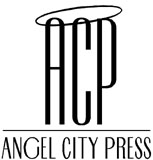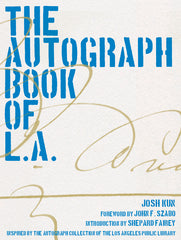The Autograph Book of L.A.
The Autograph Book of L.A.
Improvements on the Page of the City
by Josh Kun / Foreword by John F. Szabo / Introduction by Shepard Fairey
LOS ANGELES—The autograph is the premise for a dream: maybe, just maybe, the autograph hunter will become the autograph hunted, maybe the autograph will double as a magical transfer of renown, and by receiving the signature, one day you will be signing your name when someone asks. So surmises Josh Kun in the pages of The Autograph Book of L.A., the third in his trilogy of books sponsored by the Library Foundation of Los Angeles and based on the Special Collections of the Los Angeles Public Library.
But leave it to MacArthur Fellow and culture communicator par excellence Kun to take the concept of “autographs” beyond the mere signing of names in little forget-me-not books. He looks at Los Angeles, his hometown, and sees the stamp of other people who also call it home. Suddenly imagery, graffiti, and yes—hand-written names—become the signature of a new Los Angeles, far beyond the one envisioned by Charles Lummis, the city librarian who created the LAPL autograph collection by soliciting a cache of famous people’s signatures on the library’s own embossed stationery.
A big booster of his adopted city, Lummis was named Los Angeles’s City Librarian in 1905 and launched the autograph collection in 1906, inspired by his interest in the importance of autographs to gauge social value. For him, signatures and individuals’ statements were a way to document the century, a way to remember those who had risen above the common man—“People Who Count,” as Lummis called them. The initial list of respondents is a testament to its times: John Quincy Adams, Mark Twain, Andrew Carnegie, Jane Addams, Frederic Remington, Lillie Devereaux Blake, The Wonderful Wizard of Oz author L. Frank Baum, John Muir, and many, many more.
Seeking to expand the collection in 2018, Kun, librarians from LAPL, and the Library Foundation of Los Angeles recreated Lummis’s original library stationery and sent it to a variety of Angelenos—writers, entertainers, activists, scientists, artists and thought leaders. Messages and autographs came flooding in. In a contemporary and democratic twist, Kun reached out to the public at LAPL branches across Los Angeles to reframe the notion of “People Who Count,” asking patrons to share their own signature stories from their own streets and neighborhoods. “I just want to be part of it,” wrote David Gurnick from Chatsworth, California. Stitchin’ Sistahz Quilt Circle listed their members, the Skid Row artist Shugga left a signature, three-and-a-half-year-old Abby Sanchez created a drawing, and an LAPD officer wrote “Lemme see your hands.”
World-renowned graphic artist and activist Shepard Fairey, who penned the Introduction to The Autograph Book of L.A., writes: “I never was a traditional graffiti artist, but the premise—to leave your mark where someone else will be forced to see it—has always resonated with me. That thing of writing on stuff: it’s saying I exist, but also, I exist in a way that dominates you.”
Chaz Bojórquez, considered a pioneer and “godfather” of East Los Angeles Cholo-style graffiti for more than fifty years, notes in his essay, “I loved Grauman’s Chinese Theatre. When I would see the handprints and footprints of all the famous actors, I would stick my footprints inside theirs; I would put my hands in their handprints...I could almost fit my finger into the lines of their writing and mimic and reproduce their actual signature as they were leaving it in the concrete. It made me feel like it was mine, like I was a celebrity, too. I had the same feeling when I started writing and painting on walls. It makes you known, makes you immortal, makes you think you can last forever.”
In his Foreword, Los Angeles City Librarian John F. Szabo looks at the LAPL’s special collections as critical holdings of the 72-branch library system: “More than anything, public libraries are about the people they serve, and preserving special collections is one of the ways they can ensure that the stories of their communities will be told. This is true of the autographs in this book and the ‘improvements to the page.’”
The Autograph Book of L.A. launches with a companion exhibition curated by Kun and on display in the famed Los Angeles Central Library in Downtown Los Angeles. Both the book and exhibition are projects of the Library Foundation of Los Angeles.
For Kun, the challenge was to make autographs relevant to the city writ large. With his wit, his eye and his words, he met the challenge and brought a new perspective to a question as simple as “Can I have your autograph?” Readers will be getting out their Sharpies and practicing their signatures.
- 224 pages
- 200+ images
- 12"h x 9"w
- hardcover; ISBN 978-1-62640-059-7; $45.00
About the author:
- Josh Kun is Professor of Communication and Journalism at the USC Annenberg School, where he holds the Chair in Cross-Cultural Communication. He is an author and editor of several books, including two previous collaborations with the Library Foundation of Los Angeles: Songs in the Key of Los Angeles and To Live and Dine in L.A. As a curator and artist, he has worked with the San Francisco Museum of Modern Art, the California African American Museum, the Getty Foundation, the Grammy Museum, and the Contemporary Jewish Museum, among others. A MacArthur Fellow, he is also the winner of the 2018 Berlin Prize, which is awarded by the American Academy in Berlin, and the 2006 American Book Award, for Audiotopia: Music, Race, and America.

